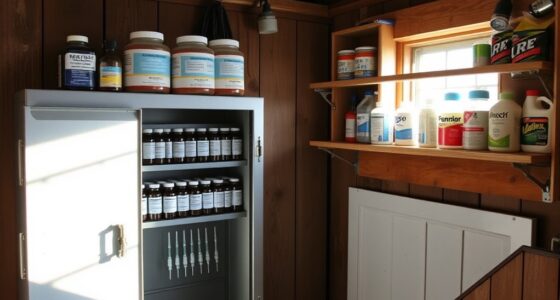During emergencies, maintaining pet sanitation and managing waste is essential to prevent infections and odors. Use gloves and sturdy bags to clean up waste promptly, and consider burying waste in a secluded area if trash disposal isn’t available. Regularly clean your pet’s living space with safe disinfectants and ensure water supplies remain clean with filtration. Balancing resource limitations with hygiene practices helps keep your pets safe and comfortable—continue for more tips on effective waste solutions.
Key Takeaways
- Prepare waste disposal supplies such as sturdy bags, gloves, and pet-safe disinfectants ahead of emergencies.
- Designate outdoor waste areas or dig temporary holes away from water sources for burying pet waste.
- Double-bag and securely store waste if standard disposal options are unavailable to prevent contamination.
- Regularly clean pet living spaces with safe disinfectants to minimize bacteria and infection risks.
- Maintain proactive hygiene routines to reduce health hazards for pets and household members during emergencies.

Keeping your pets clean and managing their waste responsibly are essential for a healthy, hygienic home, especially during emergencies when resources might be limited. Pet hygiene becomes even more critical in stressful situations, as compromised sanitation can lead to infections or the spread of disease. Proper waste disposal methods help prevent unpleasant odors, attract fewer pests, and maintain a safe environment for everyone. During emergencies, you may not have access to your usual supplies, so it’s important to have a plan for managing pet waste effectively.
Proper waste management and hygiene are vital for pet health during emergencies.
Start by gathering basic supplies ahead of time, such as sturdy plastic bags, disposable gloves, and cleaning agents suitable for pet waste. When cleaning up after your pets, always wear gloves to protect yourself from any bacteria or parasites that might be present. Use the plastic bags to pick up waste and tie them securely before disposal. If you have access to a designated outdoor area, create a specific spot for waste so it doesn’t become a hazard or attract pests to your living space. If outdoor disposal isn’t an option, double-bag the waste and place it in a sealed container until you can dispose of it properly. Avoid leaving waste around your home or in open trash bins, as this can quickly lead to unpleasant odors and hygiene issues.
In situations where waste disposal options are limited, you can consider alternative methods such as digging a temporary hole in a secluded area away from water sources, where you can bury waste safely. This method helps contain contaminants and prevents the spread of germs. Regularly cleaning your pet’s living space is also crucial; use disinfectants that are safe for pets to eliminate bacteria and maintain pet hygiene. This reduces the risk of infections and keeps your pet comfortable during stressful times. Additionally, using water filtration systems can help ensure that any water used for cleaning or drinking is free from harmful contaminants, which is especially important when resources are scarce. Remember that maintaining good hygiene isn’t just about cleanliness—it’s about preventing illness and making your pet feel safe.
During emergencies, staying proactive with pet hygiene and waste disposal can make a significant difference. It minimizes health risks for your pets and your family while helping you keep your environment sanitary. Keep a routine for waste management, and adapt it as needed based on available resources. By doing so, you ensure your pet’s well-being and contribute to a cleaner, safer living space in challenging circumstances. Proper pet hygiene and responsible waste disposal are vital parts of emergency preparedness, safeguarding everyone’s health and comfort, no matter what situation arises.
Frequently Asked Questions
How Can I Prevent Pet Waste From Contaminating Water Sources During Emergencies?
To prevent pet waste from contaminating water sources during emergencies, you should focus on pet waste containment and water source protection. Always dispose of pet waste in designated containers away from water supplies. Use biodegradable bags for easier cleanup, and keep pets away from streams, lakes, or reservoirs. Regularly sanitize waste areas and ensure proper disposal to minimize contamination risks, safeguarding your water sources effectively.
What Are Eco-Friendly Options for Pet Waste Disposal in Disaster Situations?
Imagine finding a way to protect your pet’s waste while helping the environment. Eco-friendly options include biodegradable bags, which break down naturally, and composting solutions that safely decompose waste when conditions are right. You can keep disaster areas cleaner and safer by using these sustainable methods. Not only do they minimize pollution, but they also give you peace of mind, knowing you’re making a positive impact during emergencies.
How Do I Handle Waste Management for Multiple Pets in a Temporary Shelter?
In a temporary shelter with multiple pets, you should establish clear pet waste containment areas, like portable litter boxes or designated outdoor spots, to keep the space clean and odor-free. Implement emergency sanitation planning by providing ample waste disposal supplies and scheduling regular cleanups. Train volunteers or caretakers on proper waste management, and consider eco-friendly waste disposal options to minimize environmental impact while ensuring your pets stay healthy and comfortable.
What Supplies Are Essential for Pet Sanitation During a Crisis?
Think of sanitation supplies as your pet’s hygiene superheroes, ready to save the day. You’ll need essentials like biodegradable waste bags, disinfectants safe for animals, paper towels, and hand sanitizer. Don’t forget a scoop or scoopable litter if your pet uses a litter box. These supplies help keep your pet’s environment clean and safe, preventing the spread of germs and ensuring their comfort during emergency situations.
How Can I Train Pets to Use Designated Waste Areas During Emergencies?
You can train pets to use designated areas during emergencies by establishing consistent routines. Start by taking them to the designated spot frequently, especially after meals and playtime. Use positive reinforcement like treats and praise to encourage them to go there. Be patient and persistent, gradually reinforcing the habit. Over time, your pet will associate the designated area with bathroom needs, making emergency sanitation much easier.
Conclusion
By staying prepared and managing your pet’s waste properly, you’re helping prevent health hazards and keeping your furry friend safe. Remember, in emergencies, it’s better to be safe than sorry—don’t let messes pile up and turn into bigger problems. With a little effort now, you’ll be able to face any situation head-on, knowing you’ve got it all under control. After all, a clean environment is the foundation for your pet’s well-being, even when chaos surrounds you.










